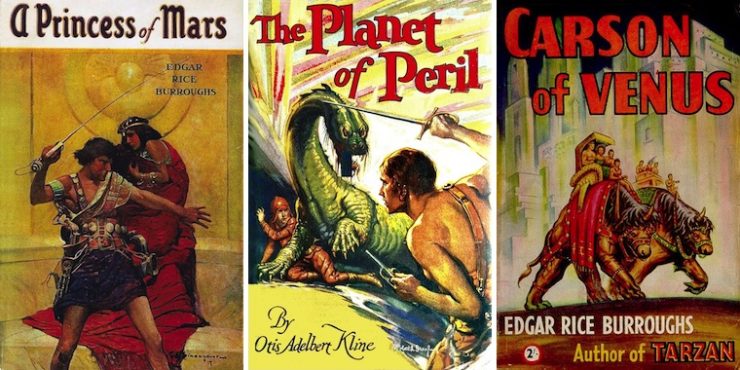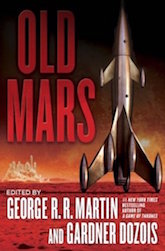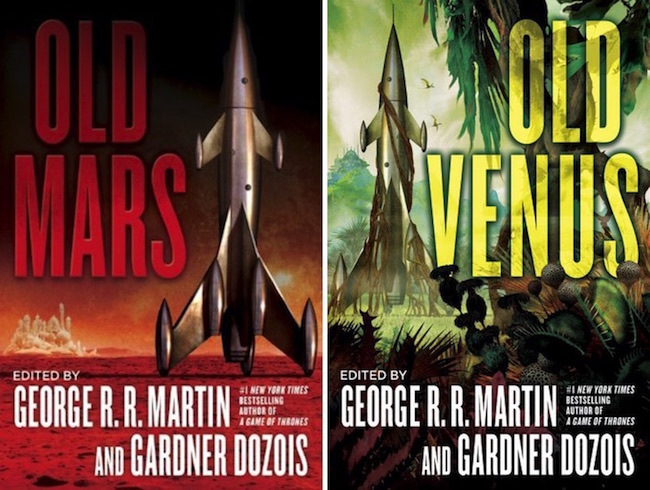In this bi-weekly series reviewing classic science fiction and fantasy books, Alan Brown looks at the front lines and frontiers of the field; books about soldiers and spacers, scientists and engineers, explorers and adventurers. Stories full of what Shakespeare used to refer to as “alarums and excursions”: battles, chases, clashes, and the stuff of excitement.
Today’s review looks at a pair of books that, despite being published in 2013 and 2015, harken back to an older style of science fiction, back to the days when Mars and Venus were depicted as not only habitable, but inhabited. Back when the planets were home to ancient races, decaying cities, mysteries and monsters. Back to the days before interplanetary probes brought back harsh truths about our neighbor planets. Back to the days of Old Mars and Old Venus.
The recent death of Gardner Dozois had me thinking about his many significant contributions to science fiction, especially as one of the leading editors in the field—and when I think of his body of work, it was his anthologies that I most enjoyed. Having just finished two of them, Old Mars and Old Venus, which Dozois edited with his frequent anthology partner, George R. R. Martin, I thought this might be a good opportunity to review a sample of his work and spend some time talking about fun adventure stories written in the old style.
While I recently argued that John Campbell could be called the father of modern science fiction, you could easily make a strong case that Dozois was the father of the next generation. In twenty years of editing Asimov’s Science Fiction magazine, and over three decades editing The Year’s Best Science Fiction anthology series, he had a remarkably profound and positive impact on the field. I still remember encountering the Year’s Best anthologies with the third volume and being blown away by the quality of the stories—as well as the scholarship involved in his summaries of the state of the science fiction field. Stories that stand out in my memory from that anthology include “The Jaguar Hunter” by Lucius Shepard, “Green Days in Brunei” by Bruce Sterling, “Flying Saucer Rock & Roll” by Howard Waldrop, and “Green Mars” by Kim Stanley Robinson. Dozois introduced me to authors I had never encountered before, and authors I wanted to read again. He worked hard to promote the careers of talented new writers. And just as Campbell brought more mature narratives and more believable science and characters to science fiction as an editor, Dozois promoted excellent writing and a more literate approach to the field. He promoted diversity both in authors and in characters. He also welcomed more progressive attitudes in the stories he selected. At the same time, he sought out stories that preserved the fun and sense of adventure that the field is known for.
These two anthologies rank among the best of Dozois’ work, as do all the anthologies on which he collaborated with Martin. There is a wide diversity of stories; some simply fun, some dark and scary, some absurd, and some full of adventure. Dozois clearly had a lot of “go to” authors whose work appears frequently in his collections, but when you know writers as good as these are, favoritism is definitely an asset. Unfortunately, my decision to review two books in one column does not permit me to discuss every story in the collections, so I will focus on the ones that I enjoyed the most. That makes for some hard decisions, because the stories are all outstanding, with nary a clinker among them…
About the Editors

George R. R. Martin (born 1948) is an American fantasy, horror, and science fiction author, as well as a television writer and producer. He made his first science fiction sale to Galaxy magazine in 1970, and sold his first novel in 1976. He began writing for television with a Twilight Zone revival, then for Max Headroom, and then as a writer-producer for Beauty and the Beast. He continued to write fiction, and started editing and overseeing the Wild Cards shared-world anthologies, a series that is still ongoing. In 1996, the epic fantasy novel A Game of Thrones was published, the first book in the A Song of Ice and Fire series, of which five volumes have been published to date. The books have been critically acclaimed for their gritty realism, compelling characters, and complex world building. The ASoIaF series has been adapted as a wildly popular television series for HBO, ranking among the most popular cable television shows ever, which will air its final season next year. The series has won many Emmy and Hugo awards. Martin’s writing, which now includes over ten novels and story collections, has garnered him four Hugo Awards (not including those won by the HBO series), two Nebulas, and numerous other awards. [Note: Like everyone else, I look forward to the next installment of A Song of Ice and Fire. But I also respect Martin’s right to live his life, and manage his time as he sees fit. So please, save any comments related to your desire for him to get busy finishing the next book for another time. We already know how you feel.]
Gardner Dozois (1947-2018) was a noted editor and author of science fiction. As mentioned above, he edited Asimov’s Science Fiction magazine from 1984 to 2004. He created the anthology series The Year’s Best Science Fiction in 1984, and edited the annual collections until his death. He also edited dozens of themed anthologies with a variety of collaborators over the years. He won a staggering fifteen Hugo awards for his editing work. His fiction writing output consisted primarily of short works, although he produced one solo novel and participated in two collaborations. He won two Nebula awards for short stories. From seeing him at various conventions, I remember Gardner Dozois being a big man with a big personality, someone who seemed to be enjoying both his life and his work. There were numerous testimonials and tributes from writers after his recent death, as he had done much to aid and promote new authors, helping them to start their careers and hone their craft. I think Dozois will be best remembered for improving the literary quality of the science fiction field, while at the same time maintaining the genre’s signature sense of adventure.
The World of Planetary Romances

The planetary romance sub-genre grew out of the pulp fiction magazines of the early 20th century, with Edgar Rice Burroughs being one of the most notable of the early practitioners. When he wrote A Princess of Mars in 1912, the first tale of the Barsoom series featuring John Carter, Burroughs created a template for much of what followed: without much attention paid to how, exactly, he’s traveled to another world, a heroic adventurer encounters all sorts of strange and exotic cultures and creatures, and usually finds a beautiful princess to save. Otis Adelbert Kline was another early author who wrote similar tales set on Venus (with some suggesting those tales were too similar), and Burroughs eventually responded with Venusian adventures of his own in the Carson Napier of Venus series. And soon enough, whole magazines were filled with stories set on exotic worlds. Planetary romances even appeared in comic strips following the adventures of Buck Rogers and Flash Gordon.
The worlds featured in planetary romance were versions of the planets of our solar system, and there was a loose consensus among writers of the time that most of them were habitable, if not necessarily inhabited by either humans or humanoids. Mercury was tidally locked with the sun, with a hot side, a cold side, and a thin habitable twilight zone between them. Venus was hot and cloud-covered, covered with jungles, swamps, and seas filled with teeming life. Mars was a dying planet, dry and cold, a land of deserts and abandoned cities. Jupiter was heated by internal radioactivity, allowing its moons to be habitable, and in some tales the planet itself harbored life. Even Saturn, the outer planets, and their respective moons were sometimes portrayed as habitable. The planets’ atmospheres were described as breathable, and their chemical composition similar to that of Earth. Freed from the need to focus on scientific fact, authors populated these worlds with all sorts of exotic flora, fauna, civilizations, ruins, and mysteries.
I have always had a fondness for these tales, and have previously reviewed Leigh Brackett’s adventures of Eric John Stark and C. L. Moore’s tales of Northwest Smith. Stanley G. Weinbaum, while focusing more on science, also set his adventures on planets that fit into the planetary romance template.
Many readers of science fiction consider the publication of two stories by Roger Zelazny as marking the end of the planetary romance era, with “A Rose for Ecclesiastes” from 1963 being set on Mars, and “The Doors of His Face, the Lamps of His Mouth” from 1965 being set on Venus. On the other hand, given evidence like the two volumes presently being reviewed, we might instead see these stories as merely the first of many homages to the pulp tales of yore.
Old Mars
Buy the Book


Old Mars
The book opens with a very personal introduction from George R.R. Martin, which describes growing up in the gritty town of Bayonne, New Jersey, and escaping into tales of planetary adventures. “The Wreck of the Mars Adventure,” by David D. Levine, is a lot of fun, describing how pirate Captain Kidd is offered a pardon if he leads a pioneering journey to Mars in a ship that can sail the currents of outer space. This story is a prequel to Levine’s series of novels that begins with Arabella of Mars. S.M. Stirling’s “Swords of Zar-Tu-Kan” is a gritty adventure tale of derring-do and treachery, which takes place in the same setting as his recent pair of planetary adventure books, The Sky People and In the Courts of the Crimson Kings.
With “In the Tombs of the Martian Kings,” Mike Resnick introduces us to the hard-bitten adventurer Marcus Aurelius Scorpio, aka the “Scorpion,” and his mysterious telepathic companion Merlin, who most others mistake for an unintelligent animal. Scorpio, who one could easily imagine sitting at a bar with Northwest Smith or Eric John Stark, is hired to find an ancient tomb, which leads to the unleashing of powers better left undisturbed and an interesting business proposition.
Howard Waldrop can always be counted on to provide a bit of wit and whimsy, and “The Dead Sea-Bottom Scrolls” is no exception, with an eccentric Terran historian attempting to recreate the journey of an ancient Martian. “A Man Without Honor” by James S. A. Corey (aka Daniel Abraham and Ty Franck) is strikingly different from their more scientifically accurate novels about The Expanse. A crew of Terran mariners find themselves swept away by a spaceship, help it battle its way back to its home planet, and find a new life swashing and buckling across Mars.
In “The Lost Canal,” Michael Moorcock, who is no stranger to planetary romance, gives us the tale of a hard-bitten adventurer on a mission to defuse a bomb that’s capable of igniting a Mars-shattering kaboom. In a touching tale more focused on family relationships than adventure, “The Sunstone,” Phyllis Eisenstein brings a young man home from college on Earth to find his father missing, and in the search that follows, discovering his own destiny. “The Queen of Night’s Aria” by Ian McDonald is a story that serves up horror and comedy in equal measures, as we follow the travels of a has-been musician who is on a tour to entertain troops fighting on Mars.
The anthology also includes excellent tales from Allen M. Steele, Matthew Hughes, Mary Rosenblum, Liz Williams, Melinda Snodgrass, Joe R. Lansdale, and Chris Roberson.
Old Venus
Buy the Book


Old Venus
This book is introduced by Gardner Dozois, with a tribute to planetary romances set on Venus as we once imagined it. In the first tale, “Frogheads,” by Allen M. Steele, a private investigator finds not only a missing person, but also cruel mistreatment of Venerian natives. Matthew Hughes brings some zany satire to the Planet of Love in “Greeves and the Evening Star,” one of those tales where a stuffy aristocrat is saved only by the sterling qualities of his loyal servant. In “Ruins,” Eleanor Arnason tells the story of a local guide, accompanied by her pet pterosaur, who leads a National Geographic team into what becomes a clash of Cold War rivals.
David Brin gives us a tale of a partially terraformed Venus in “The Tumbledowns of Cleopatra Abyss.” While mankind clings to increasingly fragile habitats in a single undersea canyon, a young man in an arranged marriage strikes out with his new bride to discover what lies beyond their claustrophobic existence. The colorfully named “By Frogsled and Lizardback to Outcast Venusian Lepers,” by Garth Nix, brings us a tale of a space navy pilot recalled to active duty on a rescue mission to one of the most treacherous regions of Venus.
Tobias S. Buckell opens “Pale Blue Memories” with American and Nazi rivals on Venus, in a tale that becomes a moving examination of the evils of slavery. “The Heart’s Filthy Lesson” by Elizabeth Bear gives us a driven archaeologist who bets her life on a desperate journey to discover the lost ruins that will validate her theories about a lost Venusian civilization. The spirit of Edgar Rice Burroughs is evoked by Joe R. Lansdale in “The Wizard of the Trees,” the story of an old buffalo soldier returning home on the Titanic from a tour with the Buffalo Bill show—who, instead of drowning, awakens in a new body on a strange world just in time to rescue an exotic princess.
In Mike Resnick’s “The Godstone of Venus,” we rejoin Scorpio and his telepathic companion Merlin, whom we last encountered in Old Mars, as they follow an alien femme fatale on a journey to awaken a lost god. The final story, Ian McDonald’s “Botanica Veneris: Thirteen Papercuts by Ida Countess Rathangan,” gives us a touching tale of an aristocratic artist’s journey to find her long-lost brother. Her artwork is so evocatively described, I found myself wishing that I could see the papercuts themselves.
Old Venus also includes outstanding work from Lavie Tidhar, Paul McAuley, Gwyneth Jones, Joe Haldeman, Stephen Leigh, and Michael Cassutt.
Final Thoughts
Both of these excellent anthologies do a great job evoking the fun and excitement of the old planetary romances, while bringing a modern sensibility to the proceedings. They demonstrate Dozois and Martin’s ability to find outstanding writers and encourage their best work. They are a fine example of Gardner Dozois’ formidable editing abilities, which raised the bar for the entire science fiction field. And now it’s time for you to comment: Have you read Old Mars or Old Venus, and if so, what did you think? And do you have any other comments on Gardner Dozois’ contributions to the field?
Alan Brown has been a science fiction fan for over five decades, especially fiction that deals with science, military matters, exploration and adventure.










